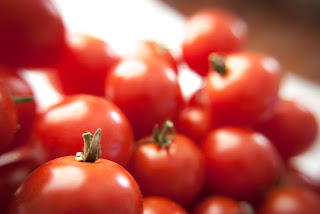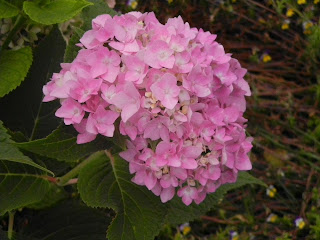The Great Tomato Challenge
 |
| photo by Steve Johnnson on Unsplash |
A couple of
years ago I wrote about “the great strawberry challenge” in which I grew
different
varieties of strawberries to see how they would do in my gardening
conditions. I am now embarking on “the great tomato challenge.” If you looked
at the picture on the right and thought I was going to tell you how to grow
beauties like that, sorry to disappoint you. That picture represents my goal,
not my achievement.
I have struggled growing
tomatoes in my garden. I get lovely plants, until just as the tomatoes are
developing. Then the plants get sick looking and die. I am quite sure that the
problem is blight. I have looked up remedies from organic to chemical and am
planning to try a variety of methods in my quest.
To start the experiment I
planted several varieties of tomatoes last week. This is about a month behind
when I would normally plant them. However, planting them earlier requires
putting “Wall O’ Waters” or some other protection around them. I have wondered
if doing so holds in humidity and contributes to the development of disease. I
don’t know that, I merely suspect it. So I planted late this year. To make up
for the late planting, I purchased fairly large plants.
I looked up blight resistant
varieties of tomatoes and found long lists. Unfortunately, most of those
varieties were not available from the nurseries where I shop. So I looked at the
labels on the plants that were available. Often they contained a long list of
letters such as VFFN or VFFNTA. Without looking it up, I can’t tell you what
each of those letters stands for, but I do know that they all are diseases.
Having the letter on the tag means the tomato is resistant to that disease, so
the longer the string of letters, the better. Of course, being resistant
doesn’t guarantee they won’t get the disease. It just means they won’t fall
over and die at the first whiff of infection. Not all of the tomatoes I chose
had those letters. Some I chose for other reasons, but I did select several
that did.
The varieties I chose are:
Beefsteak—we grew this one last year and it did quite well.
Big Boy—this is another one that did well for us last year.
Goliath—this one had a long string of letters and a short growing
time (65 days) so I had to try it.
Super Fantastic—this one had a moderate amount of letters and is
supposed to be an improvement on the old Fantastic variety. We’ll see.
Celebrity—this one had a super long list of letters, though none of
them stand for blight. But it does seem to be resistant to everything else
which can’t hurt.
Hamson—this variety was developed at Utah State University which is
only two hours from where I live and which is where my son is going to school,
so it made it into my challenge.
4th of July—this variety is supposed to produce early
(45 days) hence the name. Early varieties tend to be susceptible to early
blight, so I’ll be keeping a close eye on this one.
42 days—this variety is supposed to produce even earlier than 4th
of July. I’ll be keeping a close eye on it for signs of early blight too.
I also planted sweet 100, which
is a cherry tomato that has done well for us, but it really isn’t part of the
challenge.
My challenge is not a scientific
study. For one thing, the plants were not all planted in identical conditions.
My garden has two areas: a raised garden bed area with soft, fluffy,
rich-in-organic matter soil, and a large open area where I grow corn and
squash. Some of the tomatoes went into each area. Normally that wouldn’t make a
lot of difference since we have added a lot of organic matter to the open area
over the years. However, this year is a little different. I am the chairman of
the tree committee for the city of Shelley. In April I got a phone call from a
local nursery offering the city free trees. The only catch was that the trees
had to be picked up right away. We were not ready to plant the trees, so I had
my son dig a trench in my open garden area, and we heeled in the trees there for
a month. They were large trees which required equipment to move them. So my
garden area had pick-ups, tractors, trailers, and bobcats driving all over it
putting the trees in and then taking them out. Consequently, the soil is quite
compacted.
 Another inequity is that I put
old tires around some of the tomatoes but not others. That really wasn’t part
of the experiment, I just didn’t have enough for them all. My dad used to put
old tires around tomatoes. I think they offer a little protection to the plants
and hold in heat. I decided to try using old tires last year, and it seemed to
help some. The gross thing with old tires is that they get water in them, and
it gets green and slimy, which I doubt is good for the plants. To deal with
that, I had my husband drill holes about 2” in diameter into each tire. That
gives me a drain to pour the water out.
Another inequity is that I put
old tires around some of the tomatoes but not others. That really wasn’t part
of the experiment, I just didn’t have enough for them all. My dad used to put
old tires around tomatoes. I think they offer a little protection to the plants
and hold in heat. I decided to try using old tires last year, and it seemed to
help some. The gross thing with old tires is that they get water in them, and
it gets green and slimy, which I doubt is good for the plants. To deal with
that, I had my husband drill holes about 2” in diameter into each tire. That
gives me a drain to pour the water out.
I had enough tomato cages to put
on each plant, but as you can see from the pictures, they aren’t in the best of
condition. I’m quite sure they are older than some of my children, and my
children are all adults. So I’ve been using them a long time, and they are just
about shot. I’ve thought about buying new ones, but until I’m sure I can grow a
healthy crop of tomatoes, I’m not going to make that investment.
 Because of the inequitable
conditions, I can’t judge the varieties against one another. My goal is to try
different techniques I’ve learned and see if any of them seem to help keep the
plants healthy. The first technique I tried is to add Epsom salts and powdered
milk to the soil when planting tomatoes. I used half a cup of each per plant. I
sprinkled some in the hole and mixed some in the dirt that would back fill the
hole. I’ve tried this the past couple of years with optimistic results. A funny
Because of the inequitable
conditions, I can’t judge the varieties against one another. My goal is to try
different techniques I’ve learned and see if any of them seem to help keep the
plants healthy. The first technique I tried is to add Epsom salts and powdered
milk to the soil when planting tomatoes. I used half a cup of each per plant. I
sprinkled some in the hole and mixed some in the dirt that would back fill the
hole. I’ve tried this the past couple of years with optimistic results. A funny
So that’s it, the start of the
great tomato challenge. It may take me multiple years to get it all figured
out—I doubt I’ll be lucky enough to stumble upon the perfect solution right off
the bat, but who knows. I’ll keep you posted.



Comments
Post a Comment